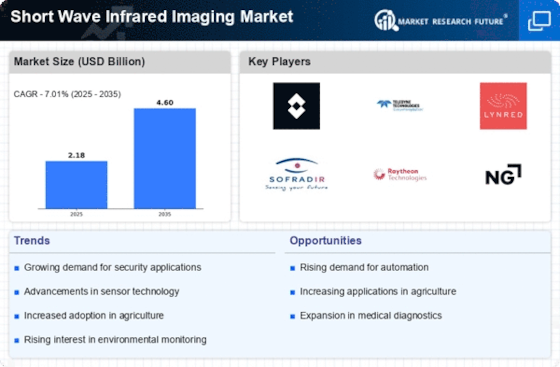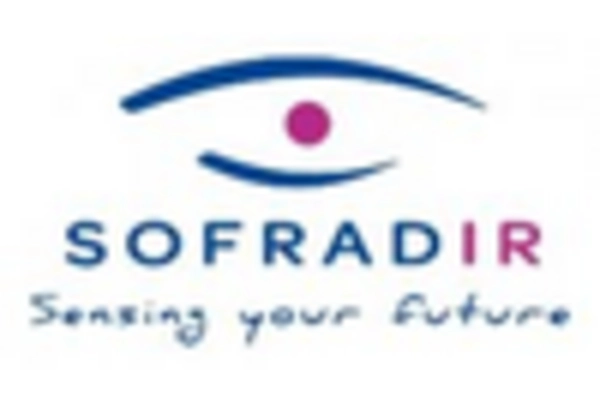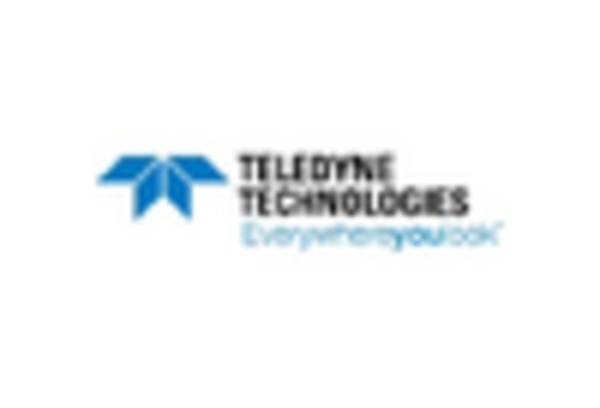Growing Demand in Healthcare Applications
The Short Wave Infrared Imaging Market is witnessing a growing demand for imaging solutions in healthcare applications. The ability of short wave infrared imaging to penetrate biological tissues without causing harm makes it an attractive option for medical diagnostics and surgical guidance. This technology is particularly beneficial in detecting tumors and monitoring tissue health. Recent studies indicate that the market for medical imaging is expected to reach USD 50 billion by 2026, with short wave infrared imaging playing a pivotal role in this growth. The increasing prevalence of chronic diseases and the need for non-invasive diagnostic techniques are likely to further propel the adoption of short wave infrared imaging in healthcare settings.
Increased Focus on Environmental Monitoring
The Short Wave Infrared Imaging Market is increasingly being utilized for environmental monitoring purposes. This technology allows for the detection of pollutants and the assessment of vegetation health, which is essential for sustainable development. Governments and organizations are investing in monitoring systems that utilize short wave infrared imaging to track changes in land use, water quality, and air pollution. The market for environmental monitoring is projected to grow significantly, with estimates suggesting a value of USD 30 billion by 2027. This growth is driven by the need for accurate data to inform policy decisions and environmental protection efforts, thereby enhancing the relevance of short wave infrared imaging.
Rising Applications in Industrial Inspection
The Short Wave Infrared Imaging Market is expanding due to its rising applications in industrial inspection. Industries such as manufacturing, oil and gas, and construction are increasingly adopting short wave infrared imaging for quality control and maintenance purposes. This technology enables the detection of defects, leaks, and thermal anomalies in materials and equipment, thereby reducing downtime and improving safety. The industrial inspection market is anticipated to grow at a rate of 8% annually, with short wave infrared imaging becoming a preferred choice for non-destructive testing. The ability to provide real-time insights into operational efficiency is likely to further drive its adoption across various industrial sectors.
Technological Advancements in Imaging Systems
The Short Wave Infrared Imaging Market is experiencing a surge in technological advancements that enhance imaging capabilities. Innovations in sensor technology, such as the development of high-sensitivity detectors and improved optics, are driving the market forward. These advancements enable clearer and more precise imaging, which is crucial for applications in various sectors, including defense, healthcare, and industrial inspection. The integration of artificial intelligence and machine learning algorithms into imaging systems further enhances their functionality, allowing for real-time data analysis and interpretation. As a result, the market is projected to grow at a compound annual growth rate of approximately 10% over the next five years, reflecting the increasing demand for sophisticated imaging solutions.
Emerging Applications in Security and Surveillance
The Short Wave Infrared Imaging Market is seeing emerging applications in security and surveillance. The capability of short wave infrared imaging to operate effectively in low-light conditions makes it an invaluable tool for security agencies and law enforcement. This technology enhances situational awareness and enables the detection of intruders or suspicious activities in various environments. The Short Wave Infrared Imaging is projected to reach USD 200 billion by 2025, with short wave infrared imaging playing a crucial role in enhancing surveillance systems. As security concerns continue to rise, the demand for advanced imaging solutions is likely to increase, positioning short wave infrared imaging as a key player in the security sector.

















Leave a Comment